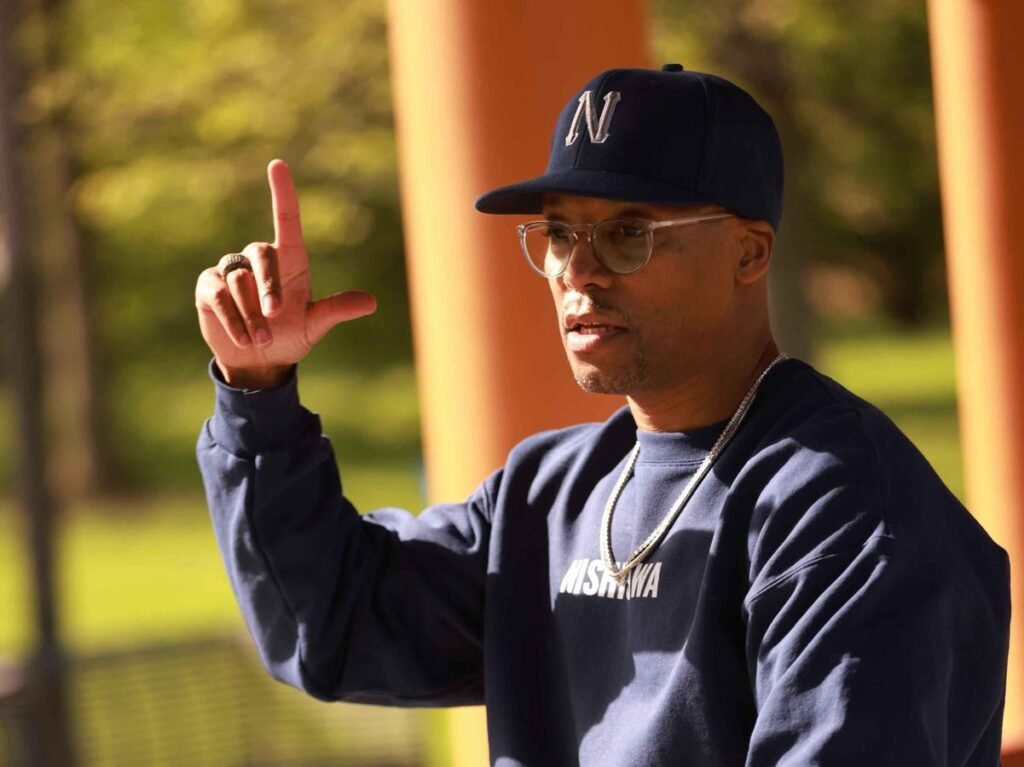Lupe Fiasco ‘Samurai’
Lupe Fiasco’s latest album is a tribute to Amy Winehouse thanks to a unique pastime.
On Friday (June 28), Lupe Fiasco dropped his 9th studio album, Samurai, a uniquely introspective work that goes beyond the typical conceptual hip-hop album. The album features eight tracks, including the self-titled single, “Cake,” all of which shared visuals alongside “No. 1 Headband,” released on the same day. The album represents Fiasco’s steady stance as a sole creative purist in this new era of his career.
“I’m just creating at this point. I try not to do the whole artist career thing anymore,” Fiasco shared in our exclusive interview last week. “I think my career is in other spaces. I do music now purely for the joy of it, not even for the entertainment value of the public. It’s more about being creative and adding to the discography.”
While Fiasco has a history of including references to martial arts in his works, Samurai is not a kung fu rendition about his life. The work, the Chicago emcee’s ninth solo effort, is a result of his pastime of curating audible portraits in honor of figures he admires. Fiasco identifies with a similar struggle of the admired and expands on the respective narrative, illustrating the story through his lens.
Cover art for Lupe Fiasco’s 9th studio album, ‘Samurai.’
In the case of Samurai, it is a portraiture of Amy Winehouse and a unique insistence that glares of the late artist’s unfeigned hip-hop connection. Fiasco drew inspiration from a moment when Winehouse referred to herself as a “samurai” battle rapper in a voice message to Salaam Remi, as highlighted in the 2015 documentary Amy, where she expressed a deep interest in the art form.
“The title comes directly from Amy Winehouse. The whole story behind this album is based on Amy Winehouse’s documentary that was released years ago,” shared Fiasco. “There was a scene in it where she leaves a voice message on Salaam Remi’s voicemail, where she says she keeps coming up with all these little battle raps. And if he ever wants to battle, you know, come, let’s battle, she’ll kill him because she’s a samurai.”
Lupe Fiasco ‘Samurai’
Crafting portraitures has been a pastime for the “Mumble Rap” lyricist over the past couple of years. He has highlighted not only the likes of Winehouse but also figures like Dick Gregory with the track “Big Energy” featured in the 2021 documentary The One and Only Dick Gregory. Fiasco considers his portraitures rather discreet, as he disclosed in our interview that they are kept “super private.”
Fiasco also teaches the concept of portraiture during his active residency at MIT as a part of their MLK Visiting Professors and Scholars Program, where he offers the course “Rap Theory and Practice.” He employs mantras in his instructional approach, guiding students on the bar use of “three-sixteens.” Earlier this year, the Grammy-winning artist performed with his student rappers as part of the MIT Festival Jazz Ensemble. This act reflects his deep appreciation for jazz—an aesthetic that permeates Samurai and Fiasco’s overall signature sound.
“I have a deep respect for jazz artists, vocalists, singers, and players. Anytime I get the opportunity to perform, like with Robert Glasper, who is a really close friend of mine, or Wendell Patrick, who teaches at the Peabody Institute, I go for it,” said Fiasco. “Recently, I did a jazz collaboration with the jazz ensemble at MIT with students from my class, and we did a big concert there. Anytime I can be in a jazz space, I seize the opportunity. I have a high level of respect for jazz musicians.”
Samurai was recorded during the pandemic at Fiasco’s home. He wasn’t in the studio with his longtime collaborator, Soundtrakk, who periodically sends Fiasco folders of beats that he often saves for months before opening. Fiasco likens the act of sifting through Soundtrakk’s beats as akin to unearthing a time capsule.
Lupe Fiasco ‘Samurai’
According to Fiasco, work on Samurai was paused to focus on 2022’s Drill Music in Zion. He resumed working on Samurai after receiving a call from his longtime manager, Chilly, who was in prison at the time. When Chilly was released, he joined Fiasco in the studio for the first time in roughly 20 years. While incarcerated, Chilly could only listen to released music and hadn’t heard any of Lupe’s demos or projects. Together with Soundtrakk, they collaborated to complete Samurai.
“Whenever I finish a record with Soundtrakk, he’ll take it and then do more post-production. The thing that was dope was having Chill here; that post-production was under his supervision. It really was the first time that Chill and I worked on music together, even though it had been 18, 19 years,” said Fiasco.
“We kind of captured them all, and it was quick. It wasn’t like we were in the studio for weeks; we were in the studio for a couple of days. Then they did a lot of post-production. I went back on the road.”
Acting on organic impulses, Fiasco creates through the art of poetry, proving himself a true wordsmith. He does not focus on making jingles, an infrequent act for him. Reflecting on the infancy of his professional rap career, he lamented that he didn’t know how to make songs properly. He estimates that he produces a satisfying song about once in every ten records.
“When you’re in the business, in the industry, I had to learn how to make songs. I didn’t know how to make songs,” said Fiasco. “During my first and second record deals, I was learning how to create songs—club songs, pop songs, all kinds. It was like a school for me.”
“I don’t think I really learned how to make records until later. You can see it on my mixtapes; there may be some interesting records, but honestly, I still don’t think I know how to make songs consistently. My ratio was like one good song out of every ten records. I think the ratio is smaller now.”
Lupe Fiasco “Samurai” Music Video
Fiasco is globally revered as a leading lyricist from the defining conscious resurgence era of the mid-2000s. His consistency, akin to exemplary artists like Jay-Z and Nas, has aided in his continued relevance in the game. This is especially true given his groundbreaking moves outside of music, such as founding the Society of Spoken Art and his contributions to academia and culture. The addition of Samurai to Fiasco’s discography stands as a testament to his longevity in hip-hop as a legacy emcee.
“We still have a studio, we still got beats, I still got raps, I still got these bars, so we’re gonna still make albums. I was always looking at Jay-Z and Nas, in terms of, how long do we have? How far can we go? Me being their junior by a decade or so. How long do we have?,” said Fiasco.
“We can do this through 50. And then it’s like, oh, can we do it through 60? Can we do it through 70?”






